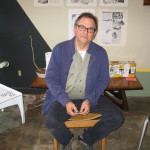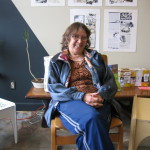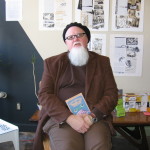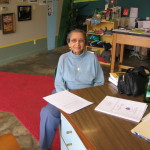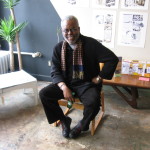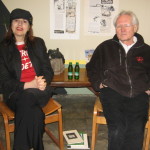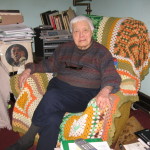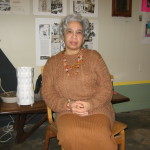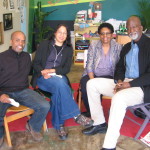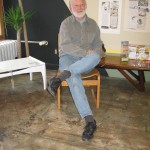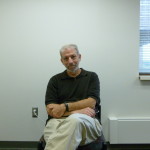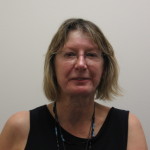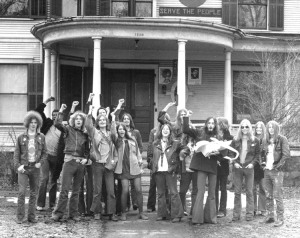The oral history of Sister Joan O’Sullivan was researched, written and read by Monika Berenyi, on behalf of Sister Joan O’Sullivan- who at the time of her oral history interview, was suffering from advanced Alzheimer’s. Sister Joan O’Sullivan passed away on April 27, 2013.
Oral History Transcription: Sister Joan O’Sullivan, CSJ, (January 9, 2013)
The story of Sister Joan O’Sullivan offers insight into to a character of remarkable devotion, whose commitment to the Congregation of the Sisters of St. Joseph has been evinced by her enduring presence in the leadership of the ministry, and by her dedication to the growth and continuity of St. Joseph’s Healthcare. This oral history attempts to provide a modest though detailed biographical sketch of an individual whose monumental life journey, accomplishments, and acts of spiritual care have touched the lives of many, most especially the community of Hamilton, Ontario.
Sister Joan O’Sullivan was born Joan O’Sullivan on March 15th, 1922, in Hamilton, Ontario, Canada. Her father, Edward O’Sullivan, was employed as a Civil Servant; and her mother, Gertrude LeHane, was a homemaker. Sister Joan had three siblings: Mary, Paul, and Herbert. Sister Joan completed elementary school and high school in Hamilton, graduating from the famed Cathedral Girls’ High School in 1939. In February of 1940, Sister Joan enrolled in St. Joseph’s School of Nursing, Hamilton, where her career in healthcare began. She graduated from St. Joseph’s School of Nursing in 1943, and shortly afterward, began working as a staff nurse at Christie Street Military Hospital, located in Toronto, Ontario, and as a private duty nurse in Hamilton. During her period of study as a student nurse at St. Joseph’s School of Nursing, Sister Joan cites Sister Mary Grace Stevens as her most cherished mentor. Sister Joan’s formative years as a nurse were undoubtedly influenced by the tumultuous effects of the Great Depression and Canada’s active participation in WWII, on the home front and abroad.
On September 8th, 1946, Sister Joan entered the Congregation of the Sisters of St. Joseph at the Motherhouse in Hamilton, which at the time, was located on Park Street. Upon entry into the Congregation, she took the name Celestine- by which she was known until after Vatican II, when she returned to her baptismal name, Joan.
She entered the Congregation as a Postulant and remained one, as such, for approximately nine months. After this period in time, it was determined by the community that she be allowed to enter the novitiate as a member of the community. Upon being received as a Novice, Sister Joan spent two full years preparing for her first vows. It was during this time that she engaged in a process of spiritual formation- which was informed by intensive study on the community’s history, mission and vision. Her first year as a Novice comprised of a canonical year, since it is required by Canon Law; during her second year, she concentrated on preparing for the ministry. Sister Joan professed her first vows on July 16th, 1949. Between 1950 and 1951, she engaged in further study of the ministry at the University of Western Ontario. Sister Joan professed her final vows on July 16th, 1952.
It was shortly before the profession of her final vows that the pursuit of Sister Joan’s ministry became inextricably linked with an enduring journey as a healthcare educator and administrator. While the extent of her accomplishments are numerous, spanning nearly a 50 year period, her contributions to St. Joseph’s School of Nursing and St. Joseph’s Healthcare, Hamilton are of monumental significance. Sister Joan’s career as a nursing educator began in 1951, at St. Mary’s School of Nursing, in Kitchener, Ontario. It was there that she taught the foundations of Nursing Arts and Science until 1955. In 1955, Sister Joan was transferred to St. Joseph’s School of Nursing, Guelph, to teach Nursing Arts and Science- and it was also there that she functioned as Director of the School from 1959-1961. Between 1961 and 1964, Sister Joan studied at the University of Western, Ontario, earning both her Bachelor and Masters of Nursing Science. It was shortly thereafter, that Sister Joan began her lengthy association with St. Joseph’s School of Nursing and St. Joseph’s Healthcare, Hamilton.
From 1964 to 1969, Sister Joan was appointed the Director of Nursing Service, St. Joseph’s Hospital, and Director of St. Joseph’s School of Nursing, Hamilton. From 1969-1973, Sister Joan was again appointed as the Director of Nursing Service, following the sudden dealt of the Director, Mary Lepinskie. In 1973, Sister Joan was appointed Assistant Executive Director at St. Joseph’s Hospital, Brantford. From 1975 to 1979, Sister Joan held the position of Executive Director of St. Mary’s General Hospital, Kitchener. It was in 1979, that Sister Joan returned to Hamilton, to function as Chief Executive Officer of St. Joseph’s Hospital- a position she held up until her retirement on December 31, 1988. . Sister Joan had a short retirement as she was elected by the Congregation in 1990, Assistant General Superior of the order.In sum, Sister Joan’s commitment to the ministry and healthcare had a remarkable impact on the formation and delivery of nursing education in the province of Ontario. Furthermore, the legacy of Sister Joan’s contributions to St. Joseph’s Healthcare, Hamilton, continues to resonate in the form of awards and annual celebrations.
Sister Joan’s legacy to St. Joseph’s Hospital and School of Nursing is one of vision, strength and fairness- true to the motto of the Sisters of St. Joseph: “It is an honour to serve the Sick”. The legacy of Sister Joan’s contributions are also often recollected with admiration by former students of the school. Throughout her tenure, Sister Joan was instrumental as an advocate of progressive social change, experimental educational techniques, and diversity. For instance, Sister Joan was the progenitor of introducing and accepting male students into the School; she accommodated and graduated a student who had become blind during her education; and she also facilitated an opportunity for a student to be brought over from Africa, to be trained as a nurse in 1966.
The following poem, which was featured in the 1965 “VOX OMNIUM”, celebrates several of the many socially progressive changes instituted by Sister Joan, namely: the removal of the ritual of morning roll call; the integration of flat shoes instead of Cuban heels; increased vacation leave to four weeks; increased sick leave; and the addition of a pool table for the gym.
(Poem from VOX OMNIUM 1965)
Her room may look foreboding
To a stranger in these parts;
The sign that rests upon the door
May cause a quiver to the heart
But venture—peer behind the desk
Adorned with book and pen
And in conglomeration find
The figure of a friend
She came to us in ’64,
Her tedious tasks began;
And special time was taken
To include these in her plan ….
She stated that there need not be
A roll call every morn;
And if we kept them polished well-
Flat ‘duties’ could be worn
Four weeks vacation she allowed,
To ‘sick time’ added more;
Late leaves bestowed upon us all
Such privileges galore.
Majestic in ‘yon’ gym there stands
A symbol of her sport,
Whereupon she strikes a game of pool
With style of a ‘pro’ of sort
It’s true we much appreciate
These things that she extends
And especially we are thankful for
The figure of a friend.
Shortly before her retirement, a celebratory article, published during the summer of 1988, reveals further insight into Sister Joan’s foremost contributions to St. Joseph’s Healthcare and to the ministry. It reads as follows:
“The Executive Director of St. Joseph’s Hospital, Sister Joan O’Sullivan, 66, says she will be retiring from St. Joseph’s this December after nine years as Executive Director and a career in healthcare that began when she graduated from that hospital’s School of Nursing in 1943. As a member of the Order of the Sisters of St. Joseph, Sister Joan has used the mandate of the Order throughout her career: “We go where the need is, and try to encourage unity and conciliation in the community.”
She is well known in the community, whether it’s for slugging a bat at a hospital baseball game or for grappling with government officials over an inadequate global hospital budget that strains special programs such as the Kidney Centre and the Respiratory Clinic. Under her direction, the hospital has added a 20-bed Dialysis Centre and established such programs as the East Region Mental Health Services, First Place Family Medical Centre, and the Hamilton Women’s Detox Centre. The hospital is also in the final year of its $.5.5-million dollar building program and hopes to break ground this summer for the St. Joseph’s Ambulatory Care Centre in Stoney Creek.
Quoting Sister Joan: “Most of my time is spent dealing with people- in committee meetings and board meetings- and trying to set policies within the philosophy of the Sisters of St. Joseph.”
Sister Joan was also publicly vocal about the desperate need in the community for greater healthcare facilities.
Quoting Sister Joan: “We’re an acute-care hospital, but on any given day, we have 60 patients that don’t need hospital-level care but have no other facility to go to, so we keep them.”
The article concludes by stating that “Sister Joan plans to continue to seek out new challenges in the ministry after she departs from St. Joseph’s Hospital.”
In 1990, on the occasion of the The One Hundredth Anniversary of St. Joseph’s Hospital and the Seventy-Fifth Anniversary of the first Graduating Class of St. Joseph’s School of Nursing, Sister Joan delivered a speech, which celebrated and detailed her recollections as Director of St. Joseph’s School of Nursing:
In Sister Joan’s own words:
“When I reflect on my years as the Director of the School of Nursing at St. Joseph’s Hospital, Hamilton, many people, programs and challenges come to mind. I arrived as the Director in 1964 and had the final decision to make regarding accepting the first young men into the nursing program. As a faculty we selected four young men and thereafter as other young men were accepted we were always proud that we had made that decision. These first young men were “semi-heroes” the afternoon of the fire in Parham Apartments where they, the interns, and interns with families lived. These young men went from apartment to apartment making sure all were evacuated before they left the building. In 1964, we were moving as a faculty to the two plus one program-two years education plus one year internship and from there the next planning was towards the two year program which was successfully achieved and approved by the College of Nurses. This landmark approval required separation of the role of the Director of the School of Nursing from that of the Director of Nursing Service and resulted in the appointment of the late Mary Lepinskie as our lay Director of Nursing Service. These progressive steps took from 1964 to 1967, and I have many memories of incidents which occurred in those years. Graduation events were always challenging. There were the Father, Mother, Son and Daughter Banquets – one which stands out in my memory.
It was 1967, the first time as a Sister that I had the privilege of addressing the grads and their parents, as I recall, in the Fischer Hotel, now of happy memory. As I completed my address, and sat down, someone from behind presented me with a black puppy – complete with a red bow – and so started the career of “Buster Fontbonne” as a permanent student in the School of Nursing. Buster went to classes with Sister Maris Stella (Ann Marshall) and me and he was often as bored as some of our students were – having slept during most of our lectures, he would then stand up, yawn and maybe have a scratch. Speaking of graduation, I recall late pre-graduation day parties and “high Jinx” whereby I threatened to cancel the graduation ceremony. (As if I could, but it did have sobering effects on the grads and resulted in “cleaning-up brigades”!)
Two other things that I would like to mention – First, the “Ouiji Board”. Remember the time that some students were getting hysterical about predictions? Consequently, at the next School meeting, I, (in my usual gentle way) stated that all three hundred students would not go out after the meeting unless the offending Ouiji Board was left at my office door by eight p.m. that night. Sister Ann and I returned to my office to wait. At eight p.m. we opened the door and, lo and behold, not one but two Ouiji Boards were waiting for us.
On another occasion, there was a fire alarm triggered by student researchers trying to determine whether or not, anything would happen if a lighted match was held to the ceiling alarm. They held the match and it happened, at eleven p.m.! That was the first and only time in my career that I held a school meeting at midnight, and it was the first time many of the three hundred plus students in front of me heard the descriptive word “nincompoops”!
I shall never forget January 19, 1972, when the Ministry announced that the Nursing programs would move from hospitals to the community colleges. I well remember the support of our faculty and students in attempting to reverse this ministerial decision but if also remember that when it was obvious that the decision was firm, both faculty and students took leadership roles in designing the new program with the other schools, Chedoke and Hamilton General and the faculty from Mohawk College. Today, our former faculty and former students are still providing leadership in the Mohawk program as well as in other Nursing Programs and Nursing Services. Thus ends this brief reflection of my years as Director of Nurses at St. Joseph’s School of Nursing, Hamilton. These were happy years for me and possibly for some students. God bless.”
It must also be highlighted that Sister Joan’s dynamic career in healthcare was also textured by her functionary role in federal and provincial governing bodies and organizations. Her list of achievements include: President of the Catholic Hospital Association of Canada; President of the Catholic Hospital Conference of Ontario; President and CEO of St. Mary’s Hospital, Kitchener, Ontario, and President and CEO of St. Joseph’s Hospital, Brantford, Ontario. Sister Joan was also publicly recognized by the University of Toronto – St. Michael’s College, for her vocational commitment to the Order at the intersection of healthcare and community service. She was awarded an Honorary Doctorate in 2002.
After Sister Joan’s retirement in 1988, she continued to support St. Joseph’s Healthcare and the Catholic Diocese of Hamilton, Ontario in various capacities. Her acts of goodwill, charity, and support have since included: functioning as Congregational Liaison for Pastoral Care to the Directors of St. Joseph’s Healthcare System; functioning as Chair of the Board of Directors to the executive operation of the Good Shepherd Brothers of Hamilton; participating as a member of the Board of Directors of St. Elizabeth Visiting Nurses Association; and participating as a member of the Board of Trustees (Executive Committee and Finance Committee) of St. Joseph’s Hospital, Brantford.
Sister Joan’s contributions in the form of leadership, education, and administration were recognized by the city of Hamilton, when in 1990, she was named woman of the year for the healthcare category. In 1998, the Hamilton Gallery of Distinction inducted Sister Joan along with 5 others, for their outstanding leadership and contribution to the city of Hamilton. Each year, the Hamilton Gallery of Distinction presents these awards to outstanding people, or members of their family who have contributed to the city of Hamilton. The broad reach of Sister Joan’s service to the city of Hamilton was articulated in the Hamilton Spectator newspaper, in an article that was published on November 7, 1998. It reads as follows:
Sister Joan O’Sullivan was born in Hamilton and graduated from Cathedral Girls’ High School before attending St. Joseph’s School of Nursing. She served as Director of the School of Nursing and was appointed Executive Director of St. Joseph’s Hospital in 1979. Her achievements include the establishment of the Regional Dialysis Centre, the rebuilding of St. Joseph Hospital, and the planning and construction of the St. Joseph’s Community Health Centre. She was named Hamilton’s woman of the year for 1990, in the healthcare category.
*Along with Sister Joan, honourees to the Hamilton Gallery of Distinction for 1990 included: Colonel Richard Beasley, Peter Gordon, Leonard Hutchinson, Dr. Fraser Mustard, and Dr. Leslie Laking.
While pursuing her dedicated commitment to healthcare administration and education, Sister Joan’s role within the Congregation has also shone as a beacon of leadership and inspiration. Within the Congregation, Sister Joan has functioned as a: member of Council from 1966 to 1972; First Councillor in 1989, and again in 1994; member of Council to the Board of Directors, St. Joseph’s Healthcare; liaison from Council for Bethany House; and liaison for healthcare of Sisters. Sister Joan has also sat on various Congregational committees, including: Constitutions; Methods for Elections; Chapter Planning; Faith and Justice; Marygrove; New Life; and the Finance Committee. Between March and June of 1989, Sister Joan also took a sabbatical to Jerusalem. Over the past recent decade, Sister Joan has been active in assisting both the Congregation and the community of Hamilton in various spiritual and benevolent capacities.
I would like to now cite several commentaries which were made by Sister Joan, which reflect, illuminate, and share her current philosophical understanding of the Order of the Sisters of St. Joseph. In conversation Sister Joan revealed her vision for the community in the following words:
“That there continue to be an openness of the Congregation to identify and respond to the needs of the poor and the marginalized in ways that promote the dignity and enhancement of life in all its dimensions- and that we continue to collaborate with other interested and dedicated persons.”
Sister Joan also cited the personal strengths that she brings to this visions as:
“Love of people and the Congregation; enthusiasm and energy in collaborating with others; and experience.”
She also humbly stated her limitations as being:
“impatience, and a tendency to want things done! yesterday”.
In her final remarks, Sister Joan reflected that:
“In the past, we (as a Congregation) have responded wholeheartedly to needs as our gifts and resources have allowed and I have great hope for the future!”
The life of Sister Joan O’Sullivan radiates as a metaphor of the Congregation of the Order of the Sisters of St. Joseph- encapsulating the journey of those who have and continue to pursue the mission of helping those in need.

